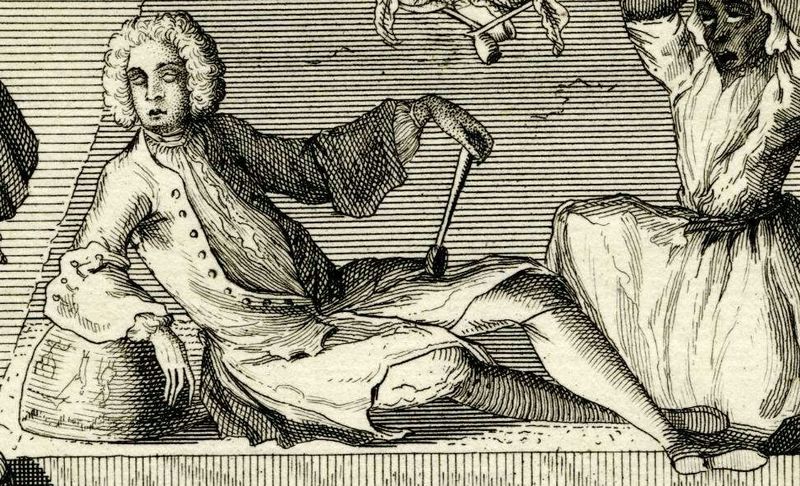Tom King (1692–1737)
Allison Muri, University of Saskatchewan
August 2024
Tom King, proprietor of the infampus Tom King's Coffee House in Covent Garden Market, was born on the 16th of November and baptized in December 1692 at Steeple Ashton, Wiltshire.[1] The baptismal record names the father only, Harman King, gentleman, though his mother was likely Ann Beach who married Harman King in the same parish on 26 March 1691.[2]
King’s entry in the Eton College Register:
Thomas, b. at West Ashton, Wilts; admitted K.S. 1708, aged about 14; admitted scholar at King’s College, Cambridge, 2 Dec. 1713; his place there seems to have been filled up in Nov. 1716, when he left in apprehension that his fellowship would be denied him; kept a coffee-house in Covent Garden, which was called after him; his widow, ‘Moll’ King—a very disreputable person—continued the coffee-house after his death.[3]
After leaving Eton he met Moll, who was selling fruit from a barrow in the streets. The anonymous Life and Character of Moll King (1747) relates that "Smooth-fac'd Tom" courted Moll and soon won her affections. The pamphlet claims the couple married at the Fleet at some point afterward, but no record has been found to confirm the date or the marriage. In any case, Moll and Tom pooled their resources (hers, from a profitable season of selling nuts from a stand, and his, from working as a waiter in a bawdy house in the Market), and rented a building (more like a hovel) on the south side of the market for their coffee house for 12 l. per year.
The coffee house proved very successful, at first selling tea and chocolate to the people of the market (thus Tom and Moll rose to open the shop at one or two o'clock in the morning, especially on market days and all through the fruit season). The convenience of these hours for late-night carousing inevitably led to the shop also becaming a popular place for men and "Misses" of the town to meet up and arrange their assignations. The Kings' house was not a bawdy house and had only beds for Moll and Tom, so the drunken couples would be compelled to adjourn to the harlot's lodgings or to a bawdy house. Tom's Coffee House became so popular that the couple leased two adjacent houses.
Moll seems to have been the driving force in their enterprise, and appears more in the literature and caricatures of their shop than does Tom, who is, however described in The Beauties of all the Magazines Selected, For February, 1764 (probably with some creative embellisment):
you would see Tom King entering, tough as a Bridewell-whipper, roaring down the long room, and rousing all the sleepers, thusting them out of doors by the neck and shoulders, if they did not immediately call for something to drink; after he had set his house to rights, three or four jolly fellows, claret elevated, would enter and put it all into an uproar again; they would drink up one person’s negus, overset another’s coffee, snatch the leg of a goose from a third, pull a fourth by the nose, kick a fifth’s shins; till pell mell, higgle-de-piggle-de all the guests in the long room were at battle-royal together.
Though it was a riotous place, Moll and Tom’s Coffee House was not a brothel as is sometimes reported. In addition to coffee, tea, and chocolate, they sold liquor and food, and in part due to their hours of operation the house attracted not only the market people but also prostitutes, criminals, beaus, and wits from the nearby theatres and gaming houses.
The establishment was so successful that they were able to purchase an estate near Hampstead at Tavistock Hill:
The Money flowing in so fast upon them, Tom, with the Consent of his beloved Helpmate, purchased an Estate near Hampstead, at a Place known by the Name of Tavistock-Hill, and on a Piece of Ground fit for the Purpose, he built a very genteel Country-House, and was determined to make as great a Figure as most of the Mercers in Covent-Garden, often declaring that he got his Money more honestly than any of them.
This rural Retirement was the Place where Tom ended his Days, a few Years ago; for having greatly impaired his Health by Drinking, and other Vices, he was obliged to be pretty much in the Country.[4]
“Thomas King, from Hampstead” was buried at St. Paul, Covent Garden, on 11 October 1737.[5]
Tom died intestate. As his Executrix, Moll sought and was granted Letters of Administration in order to deal with the estate. The "Inventory of the Goods, Chattels, and Credits of Thomas King" totalls £330 3s. 9.5 d. for his property, and £619 6s. 7.5 d. for stock, cash, and money owed,[6] but Moll seems to have made sure the estate was undervalued since she was fighting a claim against it.[7]
[1] Wiltshire and Swindon History Centre; Chippenham, Wiltshire, England; Wiltshire Church of England Parish Registers 730/6.
[2] Wiltshire Marriages Index 1538–1933.
[3] Richard Arthur Austen-Leigh, Eton College Register 1698–1752 (Eton: Spottiswoode, Ballantyne & Co., 1927), 201.
[4] Life and Character, 13–14.
[5] City of Westminster Archives Centre; Westminster Church of England Parish Registers STP/PR/1/3.
[6] PROB 3/36/147, National Archives, Kew.
[7] Strutton v. King, C 11/529/37, National Archives, Kew. Allison Muri, forthcoming.
